系列文章目录
经过之前对于MOOSapp类各个成员函数的学习,我可以进一步继续此次实验了。这篇文章主要是接MOOS编程入门(1)这篇文章的续写部分
提示:写完文章后,目录可以自动生成,如何生成可参考右边的帮助文档
文章目录
- 系列文章目录
- 四、写自己的moosapp
- 1.完成初步内容
- 2.对程序进行编译
- 3.查看程序效果
- 五、修改moosapp
- 总结
四、写自己的moosapp
不多逼逼,直接跳到续写部分~
1.完成初步内容
(3)编辑Odometry.cpp来订阅变量NAV_X 和 NAV_Y
1
2
3
4
5
6
7
8
9void Odometry::RegisterVariables() { // m_Comms.Register("FOOBAR", 0); Register("NAV_X", 0); Register("NAV_Y", 0); }
(4)给当前x,y和前一时刻x,y赋值
1
2
3
4
5
6
7
8
9
10
11
12
13
14
15
16
17
18
19
20
21
22
23
24
25
26
27
28
29
30
31
32
33
34bool Odometry::OnNewMail(MOOSMSG_LIST &NewMail) { MOOSMSG_LIST::iterator p; for(p=NewMail.begin(); p!=NewMail.end(); p++) { CMOOSMsg &msg = *p; #if 0 // Keep these around just for template string key = msg.GetKey(); string comm = msg.GetCommunity(); double dval = msg.GetDouble(); string sval = msg.GetString(); string msrc = msg.GetSource(); double mtime = msg.GetTime(); bool mdbl = msg.IsDouble(); bool mstr = msg.IsString(); #endif string key = msg.GetKey(); if(key == "NAV_X") { m_previous_x = m_current_x; m_current_x = msg.GetDouble(); } if(key == "NAV_Y") { m_previous_y = m_current_y; m_current_y = msg.GetDouble(); } return(true); } }
(4)发布计算的总里程数ODOMETRY DIST
1
2
3
4
5
6
7
8
9
10
11
12
13
14
15
16
17
18
19bool Odometry::Iterate() { m_iterations++; if(m_first_reading == 1) { m_total_distance =sqrt(m_current_x*m_current_x+m_current_y*m_current_y); Notify( "ODOMETRY_DIST",m_total_distance); m_first_reading=0; } else { m_total_distance =sqrt((m_current_x-m_previous_x)*(m_current_x-m_previous_x)+(m_current_y-m_previous_y)*(m_current_y-m_previous_y))+m_total_distance; Notify( "ODOMETRY_DIST",m_total_distance); } return(true); }
(5)总体程序
1
2
3
4
5
6
7
8
9
10
11
12
13
14
15
16
17
18
19
20
21
22
23
24
25
26
27
28
29
30
31
32
33
34
35
36
37
38
39
40
41
42
43
44
45
46
47
48
49
50
51
52
53
54
55
56
57
58
59
60
61
62
63
64
65
66
67
68
69
70
71
72
73
74
75
76
77
78
79
80
81
82
83
84
85
86
87
88
89
90
91
92
93
94
95
96
97
98
99
100
101
102
103
104
105
106
107
108
109
110
111
112
113
114
115
116
117
118
119
120
121
122
123
124
125
126
127
128
129
130
131
132
133
134
135
136
137
138
139
140
141
142
143
144
145
146
147
148
149
150
151/************************************************************/ /* NAME: Jane Doe */ /* ORGN: MIT */ /* FILE: Odometry.cpp */ /* DATE: */ /************************************************************/ #include <iterator> #include "MBUtils.h" #include "Odometry.h" #include <math.h> using namespace std; //--------------------------------------------------------- // Constructor Odometry::Odometry() { m_iterations = 0; m_timewarp = 0; m_first_reading= 1; m_current_x = 0 ; m_current_y = 0; m_previous_x = 0; m_previous_y = 0; m_total_distance = 0; } //--------------------------------------------------------- // Destructor Odometry::~Odometry() { } //--------------------------------------------------------- // Procedure: OnNewMail bool Odometry::OnNewMail(MOOSMSG_LIST &NewMail) { MOOSMSG_LIST::iterator p; for(p=NewMail.begin(); p!=NewMail.end(); p++) { CMOOSMsg &msg = *p; #if 0 // Keep these around just for template string key = msg.GetKey(); string comm = msg.GetCommunity(); double dval = msg.GetDouble(); string sval = msg.GetString(); string msrc = msg.GetSource(); double mtime = msg.GetTime(); bool mdbl = msg.IsDouble(); bool mstr = msg.IsString(); #endif string key = msg.GetKey(); if(key == "NAV_X") { m_previous_x = m_current_x; m_current_x = msg.GetDouble(); } if(key == "NAV_Y") { m_previous_y = m_current_y; m_current_y = msg.GetDouble(); } return(true); } } //--------------------------------------------------------- // Procedure: OnConnectToServer bool Odometry::OnConnectToServer() { // register for variables here // possibly look at the mission file? // m_MissionReader.GetConfigurationParam("Name", <string>); // m_Comms.Register("VARNAME", 0); RegisterVariables(); return(true); } //--------------------------------------------------------- // Procedure: Iterate() // happens AppTick times per second bool Odometry::Iterate() { m_iterations++; if(m_first_reading == 1) { m_total_distance =sqrt(m_current_x*m_current_x+m_current_y*m_current_y); Notify( "ODOMETRY_DIST",m_total_distance); m_first_reading=0; } else { m_total_distance =sqrt((m_current_x-m_previous_x)*(m_current_x-m_previous_x)+(m_current_y-m_previous_y)*(m_current_y-m_previous_y))+m_total_distance; Notify( "ODOMETRY_DIST",m_total_distance); } return(true); } //--------------------------------------------------------- // Procedure: OnStartUp() // happens before connection is open bool Odometry::OnStartUp() { list<string> sParams; m_MissionReader.EnableVerbatimQuoting(false); if(m_MissionReader.GetConfiguration(GetAppName(), sParams)) { list<string>::iterator p; for(p=sParams.begin(); p!=sParams.end(); p++) { string original_line = *p; string param = stripBlankEnds(toupper(biteString(*p, '='))); string value = stripBlankEnds(*p); if(param == "FOO") { //handled } else if(param == "BAR") { //handled } } } m_timewarp = GetMOOSTimeWarp(); RegisterVariables(); return(true); } //--------------------------------------------------------- // Procedure: RegisterVariables void Odometry::RegisterVariables() { // m_Comms.Register("FOOBAR", 0); Register("NAV_X", 0); Register("NAV_Y", 0); }
2.对程序进行编译
程序的整体架构都是采用的cmake格式,这里对源代码进行编译时也需要使用cmake来进行编译。CMake是一种跨平台编译工具,CMake主要是编写CMakeLists.txt文件。通过cmake命令将CMakeLists.txt文件转化为make所需的Makefile文件,再用make命令编译源代码,生成可执行程序或库文件。具体使用方法我主要参考如下网站:CMake方式编译
(1)项目结构
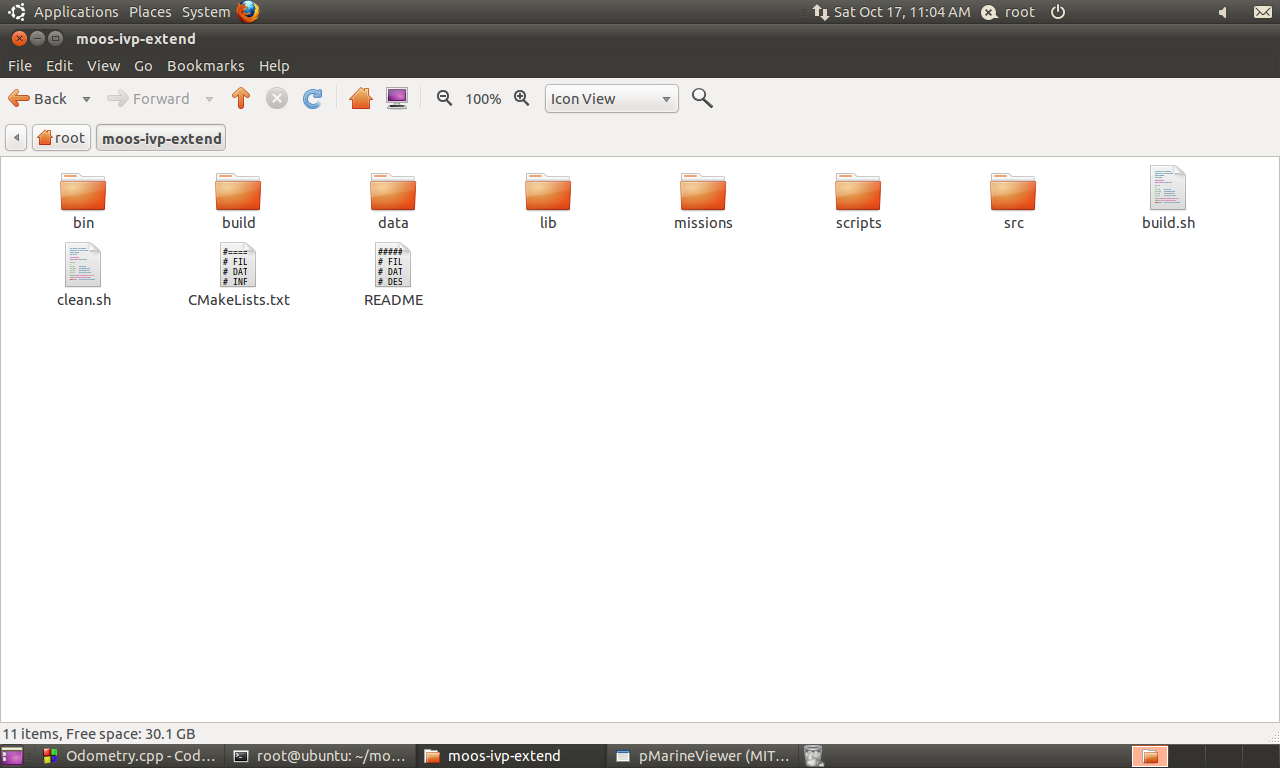
build目录 用来构建项目(编译构建中间文件等)
include目录 放置头文件。
src目录 放置源代码实现文件。
(2)CMake方式编译生成库文件
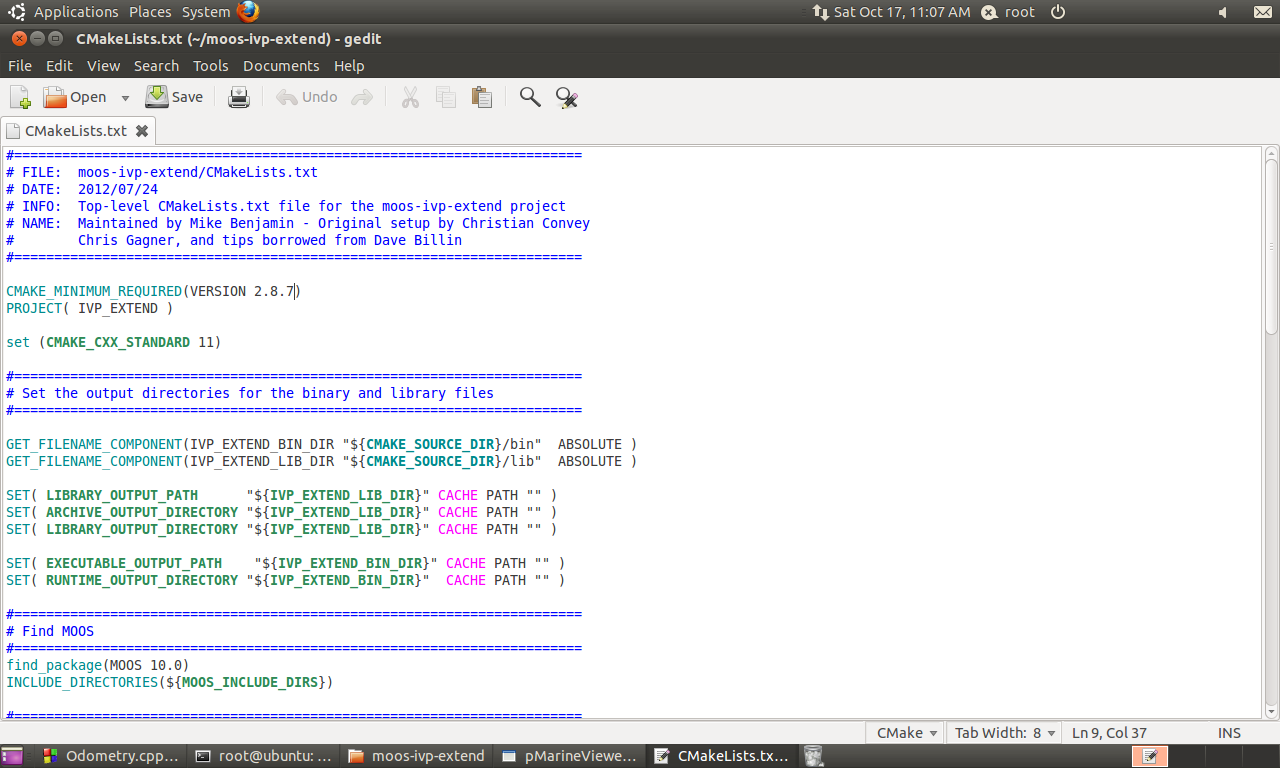
这是cmakelist文件,第一行标注的是使用的cmake版本号,可以使用
1
2cmake-vesion
来对版本号进行查看,如果版本不一致,可以在cmakelist中进行修改或者升级cmake版本。
(3)编译文件
进入到build目录中,先输入cmake进行编译,在输入make进行编译
1
2
3
4cd build cmake make
如下图显示则编译完成。

3.查看程序效果
输入
1
2
3cd moos-ivp-extend/missions/alder pAntler --MOOSTimeWarp=10 alder.moos
可以看到计算的里程数已经在界面上显示了
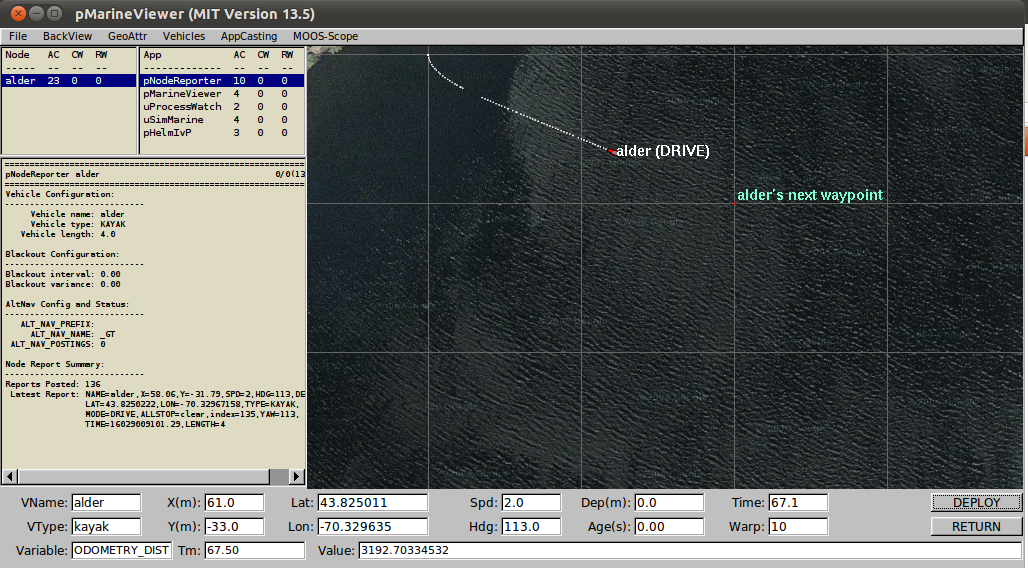
这里有一个小问题,由于NAV_X、NAV_Y两个变量是由uSimMarine这个app来进行发布的,而且发布的频率是10hz,而我们写的app默认运行频率在4hz,那么这就可能导致我们计算的里程数只有真实里程数的一半,因为中间很多消息没有订阅到。为了修改这个问题我们可以通过对moos文件进行修改。打开以下目录:

对alder.moos文件进行编辑:
1
2
3
4
5
6
7
8
9
10//------------------------------------------ // pOdometry config block ProcessConfig = pOdometry { AppTick = 10 CommsTick = 10 }
添加一个配置块,将我们app的运行频率改到10hz即可。AppTick和CommsTick决定的就是app的运行频率。
五、修改moosapp
接下来要做的任务就是对moosapp进行修改,使其航行到50m的里程的时候就返回。这个操作需要我们对Helm进行配置。有关Helm的具体设置将在后面的学习中学到,现在就是初步学习一下。
就上面的写的那个目录,打开文件 alder.bhv。对其进行编辑添加代码。加了一个condition条件:
1
2
3
4
5
6
7
8
9
10
11
12
13
14
15//---------------------------------------------- Behavior = BHV_SimpleWaypoint { name = waypt_to_point pwt = 100 condition = RETURN = false condition = DEPLOY = true condition = (ODOMETRY_DIST < 50) // <-- Add this line endflag = RETURN = true speed = 2.0 // meters per second radius = 8.0 ptx = 100 pty = -50 }
把下面的代码也进行修改,增加条件:
1
2
3condition = (RETURN = true) or (ODOMETRY_DIST >= 50) condition = DEPLOY = true
如图所示:
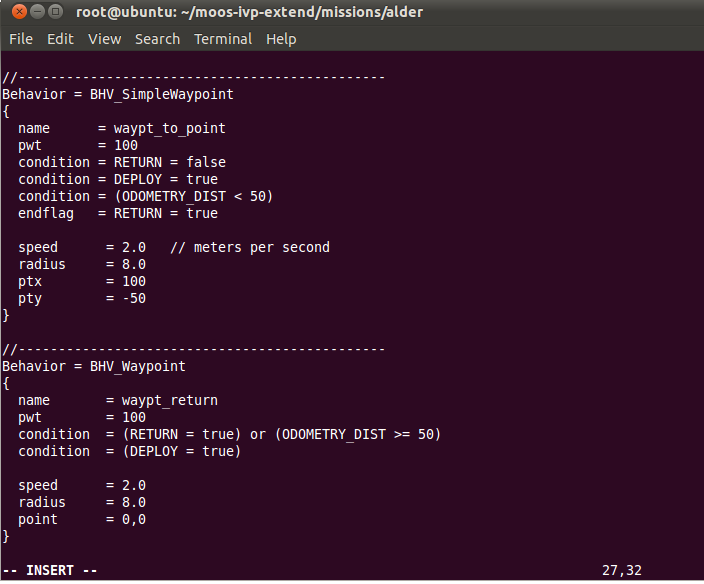
再次执行程序可以发现,AUV的航程被我们修改了:
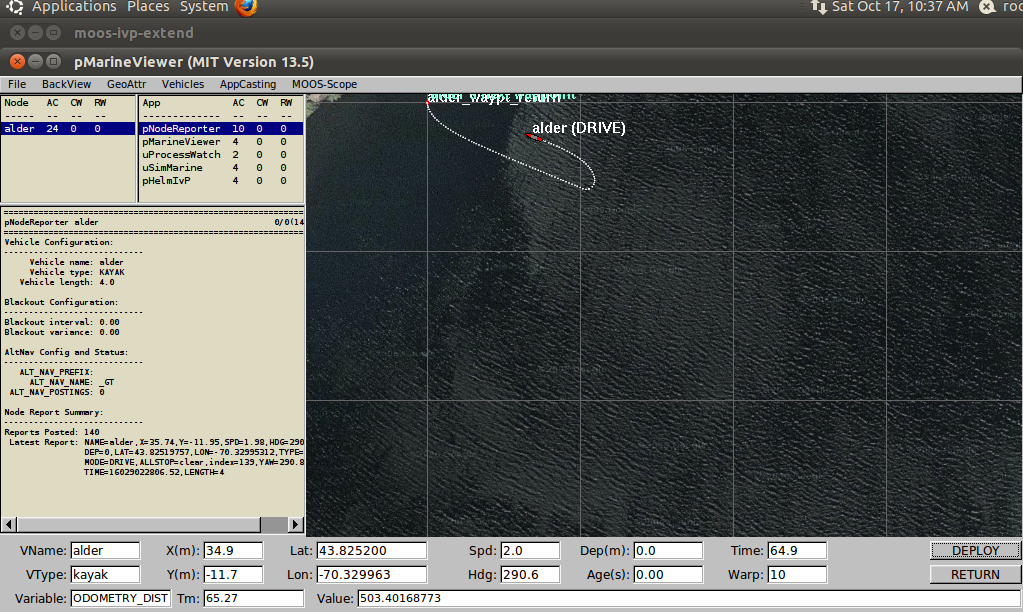
总结
对第四个实验的讲解到这里就完成了,主要完成了如何创建一个自己的app以及实现变量的订阅、发布和程序编译。
最后
以上就是高挑苗条最近收集整理的关于MOOS-ivp 实验四 MOOS编程入门(3)系列文章目录四、写自己的moosapp五、修改moosapp总结的全部内容,更多相关MOOS-ivp内容请搜索靠谱客的其他文章。








发表评论 取消回复